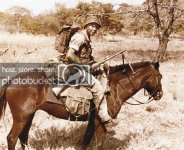Next PAM No 4, the LMG training lessons where the most compelling evidence resides. Here we see in Section 5 the following text: “The light machine gun is the principle weapon of the infantry and every man will therefore be trained to use it”. It goes on, “the rifle is the personal protective weapon of the individual, it may be needed, in an emergency to augment the fire of the section…”. Thus it is here we find solid evidence for the thinking behind the employment of the LMG in the British infantry Platoon, in a pre war version of the PAM.
We find that British thinking was precisely that of the German Army: that the Platoon was based around the LMGs and not the rifleman. Also, incidentally, in the same section we find text that shows that “infiltration tactics”, another supposed German staple, was also present in British Army thinking at the time: “this phase demands skill in the use of ground and a correct appreciation of how to apply all the available fire-power to penetrate between localities held by the enemy…”.
Also in PAM No 4 is the model ammunition scaling of an infantry section. What we see is that each rifleman was to carry only 50 rnds for his rifle – thus fitting in with the idea of the rifle being a personal self defence weapon. The 25 magazines allocated to each LMG was to be distributed between the section with each man carrying notionally, 90 rnds for the LMG in 3x magazines (although the model allocation changed over time and no doubt in practise).




